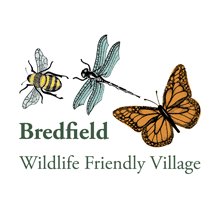Bredfield lacks woodland, but it doesn’t lack trees. We have woodland on the margins of the parish – Ufford Thicks and Dallinghoo Wood – but none wholly within the parish boundary. Our trees grow along the side of roads, by ditches, in isolated copses and in gardens. In this article, we are going to take a short tour around a few of Bredfield’s notable trees. When you’re reading this, the leaves may be off the deciduous tree, but they are still magnificent in their ‘bare bones’.
Before we begin, it is worth noting that trees outside woodland make up 30% of the nation’s tree cover. They do not provide quite the same rich ecosystem habitat that woodland does, but: they still provide food and shelter for nature; they still improve air quality and mitigate against flooding; and they still enhance the landscape. Let’s have a look at some of our trees.
When you turn off the A12 to Bredfield, onto the Woodbridge Road, a towering tree is standing there – a Lombardy Poplar. These are trees that you would expect to see lining the Italianate entrance to a large estate, but this one is standing alone. Lombardy Poplar is closely related to an iconic, but now sadly rare, tree of the British landscape – the Black Poplar. This is the tree you’ll see in the centre of Constable’s Haywain. It is a tree of wet meadows but, as these have largely disappeared, so have the trees. In addition, female Black Poplars became unpopular and were felled, because of the nuisance of their sticky cotton-like seeds. There is now a hugely disproportionate number of male trees to female trees; and you need both to propagate. Walk behind St Andrew’s church and you’ll soon come to five Black Poplars lining a ditch. However, I suspect that these may not be pure native trees, but Hybrid Black Poplars (Populous x canadensis). I’d love to know if I’m wrong! These hybrids have been planted widely for utility values, and these females don’t have those unwanted sticky seeds.

Bredfield has numerous large English Oaks (Quercus robur). If you’re standing in the field behind the church, and look north towards to Ivy Lodge Farm, you’ll see a wonderful example standing behind the gardens there. There’s another magnificent specimen by Suffolk Yurts. There are lots more Oaks around the village, including two commemorative trees planted in front of and behind the Village Hall. It will take many years before these attain the stature of ‘mighty Oaks’. At the north-end of the village, on the Village Green, stands a beautiful Red Oak. This is a North American species (Quercus rubra) and famed for its glorious autumn colour.

Those who have visited the Bredfield Fete in the private grounds of the Old Rectory, will have noticed a number of interesting conifers there. Standing tall amongst these, and visible from the road, is a Cedar of Lebanon. It has a layered appearance and a characteristic flat top. This species of tree has great cultural significance, not least in the country which bears its name. The cedar is the emblem of Lebanon and sits centrally on its flag. High on the slopes of the mountains in Lebanon is the ‘Cedars of God’, a grove of ancient trees that is now a UNESCO World Heritage Site. Anyway, we’re wandering a long way from Bredfield.
Finally, we should mention the Ash. A good number of these trees grow around the village and one of the finest and well-managed examples stands outside the house of the editor of the Bredfield Lantern magazine. One of the distinctive features of Ash are the mass of winged fruits, or ‘keys’, that develop in late-summer and autumn. Sadly, we have witnessed the prevalence of ‘Ash dieback’ in recent years; a fungus causing trees to lose their leaves and die. Ash dieback threatens the loss of the majority of Ash trees, with a significant and adverse impact on our landscape. However, research by the Forestry Commission indicates that the devastation of Britain’s Ash trees may now be slowing. Dr Joan Webber, from the Forestry Commission, says: “We are, in many parts of Britain, now past the peak and seeing a natural resistance emerging.” Fingers crossed!

I think we’re now running out of room in this article and have only touched upon a fraction of the trees that grow in and around Bredfield. Perhaps we’ll return at a later time to look at the Limes which front the churchyard, the Field Maples in our hedges, the Beeches, the Sycamores, the Willows, the Firs, and all the rest. In the meantime, look out for, and take delight in, all the trees that we are lucky to have in the village.
(Photos of Bredfield trees taken by the author)

